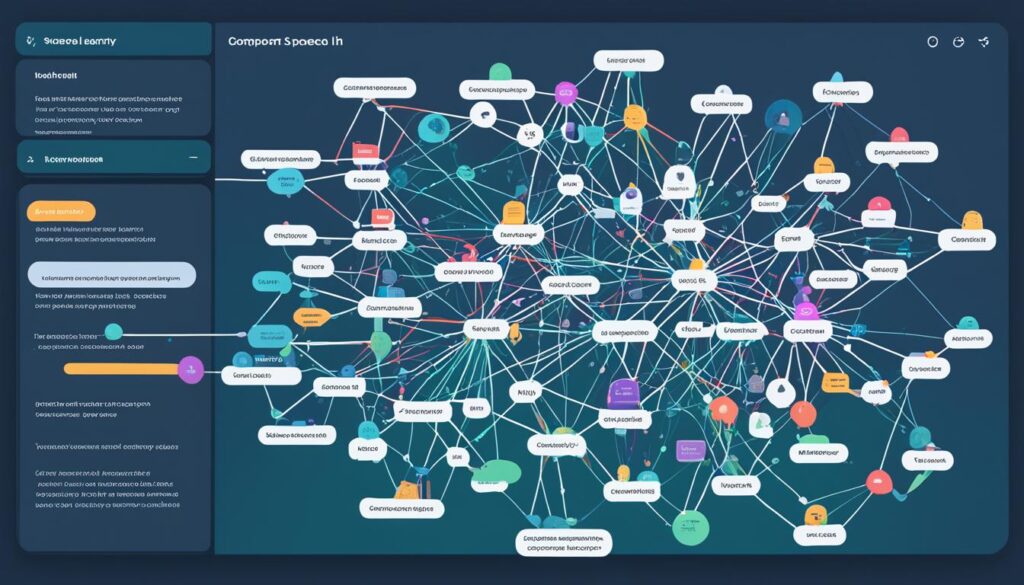AI and NLP have made huge strides, leading to advanced conversational agents and chatbots. These technologies make talking to digital systems smooth and easy. They change how we talk to and interact with computers. This piece looks into how AI and NLP work together to make smart conversations that change many fields, like customer service and healthcare.
Table of Contents
Key Takeaways
- Artificial intelligence and natural language processing are key to making conversational agents and chatbots.
- Conversational AI systems make talking to digital systems natural and easy.
- Knowing how NLP works, like understanding and creating language, is vital for making good chatbots.
- Conversational AI has three main parts: understanding language, managing conversations, and generating language.
- Creating great chatbots means solving problems like unclear messages, knowing the context, and thinking about ethics.
What is Natural Language Processing?
Natural Language Processing (NLP) is a field that helps computers understand and create human language. It’s a key part of artificial intelligence (AI). It lets machines work with and analyze lots of human language data, like text and speech. This helps machines get insights and do language tasks automatically.
Understanding Human Language
NLP focuses on understanding how humans talk to each other. It looks at the structure, meaning, and social use of language. This includes the way sentences are built, the meanings of words, and how language changes in different situations.
Applications of NLP
NLP has many uses that have changed many industries. Some main uses are text analysis, machine translation, figuring out feelings in text, and making voice-based interfaces. These include virtual assistants and chatbots.
These technologies help businesses automate customer service, make user experiences more personal, and understand data that’s not structured well.
“NLP is the foundation for building intelligent, conversational systems that can understand and respond to human language in a natural and intuitive way.”
NLP is getting more important as it grows. It will keep changing how we talk to computers and will help make new things in many areas.
AI and Natural Language Processing
Artificial intelligence (AI) and natural language processing (NLP) are now closely linked. This has led to big steps forward in making conversations between humans and machines smoother. These technologies work together to make language understanding and generation more accurate and powerful.
At the heart of this is how machine learning and deep learning are used in NLP systems. These AI algorithms have changed how computers understand, analyze, and create human language. By using neural networks and deep learning, NLP models can now understand the complex parts of language better. This makes conversations more engaging and aware of the context.
| Technique | Impact on NLP |
|---|---|
| Machine Learning | Enables NLP models to learn from data and improve their language understanding and generation capabilities over time. |
| Deep Learning | Allows for more accurate and sophisticated language processing, enabling NLP systems to capture intricate semantic relationships and generate more natural and coherent responses. |
The mix of AI and NLP has changed how we make conversational agents and chatbots. These smart systems can now talk in a more natural way, understanding and creating language better. They give personalized and relevant answers. As AI and NLP keep getting better, we’ll see more advanced and easy-to-use conversational interfaces.
“The future of natural language processing lies in the continued convergence of AI and NLP, unlocking new possibilities for intelligent and personalized conversational experiences.”
Components of Conversational AI
At the core of conversational AI are three key parts. They work together to make talking to machines smooth and fun. These parts help chatbots, virtual assistants, and other language processing tools understand, answer, and talk like humans.
Natural Language Understanding
The first step in conversational AI is natural language understanding (NLU). It’s about making sense of human language. NLU uses artificial intelligence and machine learning to look at the words, structure, and context of what users say. This lets the system figure out what the user wants and answer them.
Dialogue Management
After understanding what the user wants, the dialogue management part kicks in. It decides the best response and how the chat should go. It keeps track of the conversation, remembers what was said before, and picks the next step. This could be answering a question, asking for more details, or changing the topic.
Natural Language Generation
The last part of the chatbot architecture is natural language generation (NLG). It turns the system’s thoughts into language that people can understand. NLG uses linguistics, computational linguistics, and AI to make responses clear, correct, and fitting for the conversation.
By combining these three parts, conversational AI systems can have chats that sound natural and feel more like talking to another person. This makes the experience for users more intuitive and personal.
Challenges in Building Chatbots
Creating chatbots and conversational AI agents is tough. It faces many challenges. Two big ones are dealing with language ambiguity and keeping track of context.
Handling Ambiguity
Human language is full of ambiguity, making it hard for chatbots to get what we mean. Words can have more than one meaning, leading to confusion. This issue comes from many things like word meanings, sentence structure, and what’s happening around us.
It’s key to solve these language problems to make chatbots talk naturally and make sense.
Context Awareness
Chatbots also struggle to keep up with the context of a conversation. Humans easily pick up on past talks and what’s not said. But chatbots need to do this too to give good answers. If they don’t, conversations can sound weird and confuse users.
Chatbot makers also face other hurdles like dealing with different kinds of user input and complex questions. They must make sure the chat flows smoothly. Overcoming these chatbot challenges, language ambiguity, context awareness, natural language processing limitations, and conversational AI obstacles is key to making smart and engaging chatbots.
“The most significant challenge in building chatbots is replicating the nuance and flexibility of human communication.”
Conversational Agent Architectures
Creating effective conversational agents and chatbots needs a deep look at their parts. These conversational agent architectures have many modules and systems. Each one is key to making conversations natural and smart.
The core of a conversational agent is the language processing pipeline. It makes sense of what the user says, finds the meaning, and understands the conversation’s context. This includes natural language understanding (NLU) skills. They figure out the user’s message, what they want, and how they feel.
Then, dialogue systems manage the conversation’s flow. They keep track of the context and pick the right answer.
The last step is natural language generation (NLG). It makes the agent’s reply clear, relevant, and right for the user. All these parts work together to make smooth, AI-powered talks. Users expect this from modern chatbots and virtual assistants.
Knowing how these conversational agent architectures work is key for designers and developers. By improving how NLU, dialogue management, and NLG work together, they can make chatbot design that really connects with users. This leads to a better chat experience.
Rule-Based vs Machine Learning Approaches
Building conversational agents uses two main ways: rule-based systems and machine learning models. Each method has its own strengths and limits. They shape how chatbots and other NLP tools work.
Rule-Based Systems
Rule-based chatbots use set rules and knowledge to understand what users say and answer. They use natural language processing techniques to check user queries against set patterns. Then, they find the right answers from their knowledge base.
This method is great for simple, specific tasks. It makes interactions predictable and structured.
Machine Learning Models
Machine learning chatbots use big datasets to train data-driven conversational AI models. These models learn from lots of chat data. They use natural language processing techniques and knowledge-based systems to understand language and context better.
This lets them handle complex and open-ended chats. They can learn about language, context, and what users want.
Choosing between rule-based and machine learning depends on the chatbot’s needs, the task’s complexity, and how flexible you want it to be. Many chatbots now use both rule-based and machine learning. This mix makes them more powerful and flexible.
“The future of conversational AI lies in the seamless integration of rule-based and machine learning approaches, leveraging the best of both worlds to create truly intelligent and adaptable conversational agents.”
Data Requirements for Chatbot Development
Creating effective chatbots needs big, varied datasets of how people talk. These datasets are key for training language models. They help chatbots understand and answer user questions.
For chatbot data-driven development, you need:
- Text data: This includes chats, customer service records, and online discussions.
- Speech data: This is audio from phone calls and voice commands.
- User context: Details about the user’s likes, where they are, and what they prefer.
- Conversational logs: These are records of past chats between users and chatbots.
Finding and preparing good training data for chatbots is hard. It needs to be clean and clear, free from noise and confusion. The data must also cover a wide range of topics and users.
| Data Type | Description | Example Sources |
|---|---|---|
| Text Data | Includes chats, customer service records, and online discussions. | Customer service logs, online forums, social media, chat logs, and emails. |
| Speech Data | Audio from phone calls and voice commands. | Phone call recordings, voice command datasets, and human-to-human audio. |
| User Context | Details about the user’s profile and preferences. | User profiles, CRM data, and user behavior analytics. |
| Conversational Logs | Records of past chats between users and chatbots. | Previous chatbot logs, human-to-human transcripts, and user-chatbot dialogues. |
By picking and preparing these varied chatbot data requirements, developers can make chatbots that are more accurate and helpful. These chatbots can assist users in many ways.
Evaluating Chatbot Performance
It’s key to check how well chatbots and conversational agents work. We’ll look at both objective and subjective metrics to see how they do. We’ll focus on things like how accurate they are, how well they finish tasks, how engaging they are, and how happy users are.
Objective Metrics
Objective metrics give us hard numbers to see how well chatbots work. They look at things like:
- Response accuracy: This is how often the chatbot gives the right and relevant answers.
- Task completion rate: This shows how many users finish what they set out to do with the chatbot’s help.
- Average conversation duration: This tells us how long chats last, showing if the chatbot keeps users interested.
- User engagement: This checks how much users talk to the chatbot and start conversations, showing if they stay engaged.
Subjective Metrics
Subjective metrics look at what users think of the chatbot. They give us clues about how good the chatbot is at talking to people. These include:
- User satisfaction: This checks how happy users are with the chatbot’s speed, helpfulness, and meeting their needs.
- Perceived helpfulness: This looks at how users see the chatbot as helpful and useful.
- Ease of use: This measures how easy users find it to talk to the chatbot.
- Personalization: This checks if the chatbot gives a personalized experience to each user.
Using both objective and subjective metrics, companies can really understand their chatbots. They can see what needs work and make the chatbot better for users.
Ethical Considerations in Conversational AI
As conversational AI gets better and we use it more, we must think about the ethical considerations around it. These include things like chatbot transparency, user privacy, and making sure these AI chats aren’t used to trick or control us.
One big worry is making sure conversational AI is clear about being AI, not a real person. Chatbots should tell users they’re not human and not try to trick them about what they can do or who they are.
Another big issue is keeping user privacy safe. These AI systems can learn a lot about us, like what we like, what we buy, and even our private talks. We need to make sure these technologies are made and used in a way that keeps our privacy safe and doesn’t let them misuse our info.
There’s also a worry about bias in conversational AI. These systems might reflect and make worse the biases we already have in society, leading to unfair or discriminatory results. Developers need to be careful to fix these biases when they’re making and training these AI systems.
In the end, making conversational AI ethical means focusing on being open, keeping user info safe, and making sure these technologies are made right. By doing this, we can make the most of these technologies while keeping them honest and trustworthy.
| Key Ethical Considerations | Description |
|---|---|
| Chatbot Transparency | Users should be aware that they are interacting with an artificial agent, not a human. |
| User Privacy | Conversational AI systems collect and process sensitive personal data, which must be protected. |
| Bias Mitigation | Developers must identify and mitigate biases in the design and training of conversational AI systems. |
| Responsible Development | Conversational AI technologies should be developed and deployed with a focus on ethical principles and user trust. |
Chatbot Use Cases and Applications
The rise of chatbots and conversational AI applications has opened up many new uses across different fields. They help improve customer service, make healthcare processes smoother, and change how we shop online. These smart chat agents are changing how we use technology.
Customer Service
Chatbots are now key in customer service. They’re always there to help, giving quick support to customers. They answer questions, guide through problems, or help with buying things. They use NLP and machine learning to get what users want, give tailored answers, and get better at helping customers.
Healthcare
Healthcare is also using chatbots and virtual assistants a lot. These AI helpers help with setting up appointments, managing medicines, and supporting mental health. They take over simple tasks, giving doctors more time for complex patient care. This leads to better health outcomes.
E-commerce
In e-commerce, chatbots have changed shopping. Now, customers can talk to chatbots to look at products, get advice, buy things, or return items. These AI tools use NLP and machine learning to know what customers like, guess their needs, and make shopping smooth and personal.
| Chatbot Use Case | Key Benefits | Challenges |
|---|---|---|
| Customer Service |
|
|
| Healthcare |
|
|
| E-commerce |
|
|
As chatbots and conversational AI get better, they’ll be used more in different areas. This will change how we use technology and bring big benefits to businesses and people.
Future of Conversational AI
As AI and natural language processing (NLP) keep getting better, the future of conversational AI is exciting. We’ll see big changes in how we talk to virtual assistants and AI.
Advancements in NLP
Researchers and developers are working hard to make language understanding better. This means conversational agents will talk more clearly and make sense in different situations. Soon, they’ll understand many languages, making interactions more global and inclusive.
This will lead to more natural and personal AI-powered conversations. It will make using AI a better experience for everyone.
Multimodal Interactions
The future of conversational AI will also bring more ways to interact, like using sight, sound, and touch. This will make talking to virtual assistants feel more real and engaging. It will make it easier for conversational agents to understand what we need.
“The convergence of NLP advancements and multimodal interactions will redefine the way we perceive and utilize conversational AI in the years to come.”
As new trends in the future of conversational AI come to light, we’ll see more advanced and smart AI-powered conversations. These will blend into our daily lives, changing how we use technology.
Tools and Frameworks for Chatbot Development
The chatbot development world is always changing. There are many tools and frameworks to help developers make chatbots that talk like real people. You can find everything from open-source natural language processing libraries to top-level chatbot solutions.
Dialogflow is a top choice for open-source conversational AI frameworks. It’s powered by Google and makes building chatbots and virtual assistants easy. Developers love it for its simple interface and how it works with many platforms like the web, mobile, and messaging apps.
The Microsoft Bot Framework is also very popular. It gives developers everything they need to make, connect, and use intelligent bots. It works well with Azure Cloud, giving developers access to big cloud resources and smart services.
- Open-source natural language processing libraries like NLTK, spaCy, and BERT help chatbots understand language better. These can be added to your own chatbot projects.
- Enterprise chatbot solutions like Amazon Lex, IBM Watson Assistant, and Botkit are for big companies. They have many features like supporting many languages, advanced analytics, and top security and compliance.
- Open-source chatbot platforms like Rasa and Botpress are great for making and using chatbots. They work for many kinds of projects and places where you might use them.
Choosing the right tools and frameworks for your chatbot project is key. Think about how complex your project is, how much you need to customize it, and how it will work with your systems. With the right tools and tech, you can make chatbots that really grab your users’ attention.
Conclusion
As we wrap up our look at AI and natural language processing, it’s clear that conversational agents and chatbots have grown a lot. They make talking to technology better and more fun. By understanding natural language, managing dialogues, and generating text, these smart systems can change how we talk to machines.
We’ve looked at what makes conversational AI work, including the tough parts like understanding unclear words and knowing the context. We’ve seen different ways to build these smart chatbots, from simple rules to complex learning models. This shows how chatbot technology is always getting better.
The future of conversational AI looks bright. With better natural language processing and more ways to interact, we can expect even more natural and fun interactions. But, as this tech gets better, we must think about the right way to use it. We need to make sure these chatbots work for the people using them.













